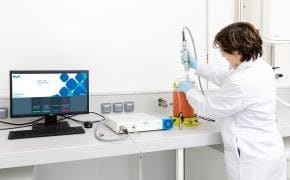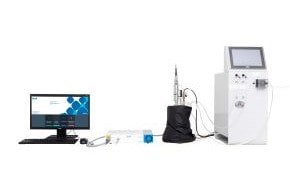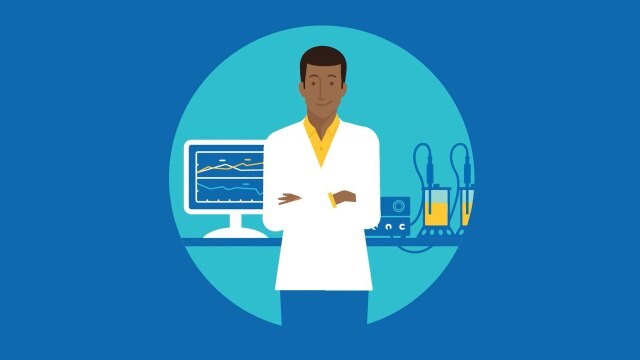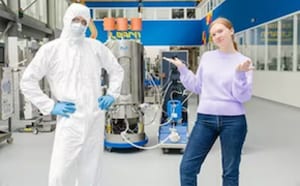PAT: Build Quality into Biopharmaceutical Process
with Real-Time Monitoring and Control
Process Analytical Technology (PAT) ensures quality in biopharmaceutical manufacturing by monitoring and controlling processes in real-time. It utilizes analytical tools to develop manufacturing processes that accommodate material and equipment variability. Once critical process parameters (CPPs) impacting critical quality attributes (CQAs) are identified, analytical methods are employed to monitor and control CPPs, maintaining them within the desired design space. This approach integrates quality by design (QbD) principles into the process rather than relying on product testing only in the end.
In-Line & Real-Time Raman Monitoring
Raman spectroscopy is among the many tools used in PAT implementation. This optical analytical technique identifies molecules by their unique fingerprint and is very well suited for biopharmaceutical processes: Thanks to its high molecular specificity and minimal disruption from water, it can monitor multiple parameters simultaneously even in complex, aqueous biopharmaceutical solutions. Raman spectroscopy enables the determination of chemical composition and molecular structure in a non-destructive and reproducible manner, eliminating the risk of losing chemical information due to degradation, instability, or sample preparation. For example, the technique can be used to monitor cell culture CPPs such as glucose, lactate, cell density, and ammonium, as well as CQAs such as protein titer, glycosylation, and aggregation. Analysis is performed by insertion of a probe into the process along with other widely used sensors; as such, Raman technology enables real-time monitoring and automation of the process, and also eliminates the need to collect samples to send to the quality control (QC) lab for analysis. However, if preferred by the user or mandated by the specific process set-up, it offers the option for on-line, at-line or off-line measurements as well.
Compared with traditional off-line analytical methods such as a cell culture multitest analyzer, cell viability analyzer or HPLC, Raman spectroscopy offers clear advantages for both upstream (USP) and downstream (DSP) processes including:
- Multi-attribute monitoring with a single probe
- Implementation of an automatic feeding strategy during cell culture growth
- Complete chemical and biological information collected in a single spectrum
- Access to real-time and in situ measurements
- Non-destructive analysis
- Easy implementation using an in-line probe or on-line, at-line, off-line mode as needed

Specifically designed for the bioprocessing industry, the ProCellics™ Raman Analyzer is an easy-to-use Process Analytical Technology (PAT) platform used to monitor USP and DSP bioprocesses, from process development to manufacturing, for qualitative and quantitative analysis.
It ensures better process understanding and enables the implementation of an automated process control strategy. In addition, the platform contributes to time savings, provides operator flexibility, and reduces contamination risk and batch failures compared to manual sampling. As a result, it empowers the user to navigate cell culture processes with confidence.

The ProCellics™ Raman Analyzer is available in two configurations, fully adaptable to manufacturing requirements, to address a range of monitoring needs, from process development to manufacturing:
The single channel unit enables the monitoring of cultures with a single probe. The package includes a base unit with a 785 nm laser, one probe, accessories, and an all-in-one computer including Bio4C® PAT Raman Software.

The multi-channel unit enables the monitoring of up to four cultures in parallel within the same system footprint. The package includes a base unit with a 785 nm laser, a multi-channel unit with four probes, accessories, and an all-in-one computer including Bio4C® PAT Raman Software.
An advanced probe tube, combined with specific software features, is available to counter the effect of light interference, eliminating the need to shield the bioreactor from light rays.
It strengthens the scalability of Raman technology across various unit operations, allowing for seamless transitions from single-use to multi-use systems, and from different scales between process development and manufacturing.
Related Categories
Our off-the-shelf and customizable bioprocessing cell culture media (CCM) products enhance productivity in upstream mAb, vaccine, gene/cell therapy processes.
The Mobius® Bioreactor family includes the bench scale (2 mL and 3 L), pilot, clinical and...
Enhance perfused seed train efficiency with our cell retention solution. Real-time monitoring and control.
Related Resources
- Datasheet: ProCellics™ Raman Analyzer with Bio4C® PAT Raman Software
Specifically designed for the bioprocessing industry, ProCellics™ Raman Analyzer with Bio4C® PAT Raman Software enables you to perform in-line and real-time measurement of CPPs and CQAs, from process development to manufacturing.
- Application Note: Enabling accelerated Raman model calibration for seamless and reproducible real-time monitoring by combining Raman and automated sampling technologies
Explore how automated sampling can accelerate the integration of a Raman analyzer for a bioreactor application, speeding up the Raman model building phase, and facilitating in-line, real-time monitoring of critical process parameters (CPPs) and critical quality attributes (CQAs) during the manufacturing process.
- Application Note: Monitoring bioprocesses in a light environment using Raman spectroscopy
This application note introduces an advanced solution to facilitate the implementation of Raman technology in laboratory and manufacturing scales, in a normal light environment, to ensure the consistent monitoring of critical process parameters (CPPs) and critical quality attributes (CQAs).
- Application Note: An innovative approach to streamline Raman implementation for cell culture processes: One-batch calibration
This novel modeling approach eliminates the need for multiple calibration batches during the Raman implementation, allowing for a more streamlined and efficient workflow.
- Application Note: Real-time and in-line Raman Spectroscopy: A Window into Glycosylation Quality Analysis
This case study demonstrates the effectiveness of Raman technology for monitoring monoclonal antibody (mAb) glycan profiles during fed-batch processes, and how robust predictive models facilitate monitoring of glycosylation profiles.
- Application Note: In-line Real-time Monitoring of CHO Cell Culture Process Parameters Using Raman Spectroscopy
Cell culture processes are complex and highly variable and yet only a handful of key parameters such as temperature, pH, and dissolved oxygen (DO) are typically controlled in real time.
- Application Note: Implementation of Raman Spectroscopy for In-line Monitoring of CPPs of CHO Cell Perfusion Cultures
This application note introduces a case study for the implementation of a Raman spectroscopy soft-sensor for in-line and real-time monitoring of critical process parameters (CPP) in mammalian perfusion cell cultures.
- Application Note: Seamless Integration of Glucose Control Using Raman Spectroscopy in CHO Cell Cultures
Process analytical technology (PAT) and quality by design (QbD) are used in the biopharmaceutical industry to ensure quality is designed into a process and to achieve innovative quality improvements.
- Application Note: Cell-free modelling approach for efficient cell culture monitoring using Raman spectroscopy
The novel synthetic model approach provides a significative gain of time and resources for the Raman calibration phase which is reduced to just a few days.
- One-Batch Calibration: A Process-, Instrument-, Scale- & Site-agnostic Method For Streamlining Raman Implementation
Challenges associated with Raman spectroscopy implementation in bioprocesses can be overcome by the innovative one-batch calibration approach. This streamlined process requires less time and resources compared to traditional approaches, unlocking Raman benefits for biopharmaceutical applications.
Related Webinars
Utilization of Raman Spectroscopy for Monitoring CPP and CQA in Perfusion.
Explore the possibilities of using Raman spectroscopy for quality control of cell culture media preparation
Utilization of automated aseptic sampling for accelerated access to process and quality data in upstream bioprocessing.
Explore the utility of on-line HPLC to monitor and control antibody aggregation levels in bioprocessing.
BioContinuum™ Platform: Your enabler of the biomanufacturing facility of the future!
To continue reading please sign in or create an account.
Don't Have An Account?











